 |
||
|
||
| ||
By Maxim Lyadov
The market of multimedia devices meant for equipping a computer with a sound subsystem can be divided into 3 sectors:
While expensive sound cards are often beyond users' pockets, old solutions from a lower price range such as ISA cards are too crippled, first PCI cards of 1997-98 support only stereo speakers leaving 3D sound API (EAX, A3D, I3DL2) aside. Is there a way out? Yes, for example, inexpensive sound cards based on HSP chips (host-based signal processing chip). Such chips contain only the least required set of functions for sound processing. The most part of calculations is made by CPU. The HSP based sound cards are rather popular. Here are some of successful HSP sound chips: YMF724/740/744/754, FM801AS/AU (reviews of the sound cards on such chips: AW744Pro from AOpen, AW754 from AOpen, ABIT Home Theatre AU10, X-treme 5.1 from MediaForte, Genius Sound Maker Live 5.1). Integrated sound may serve as an inexpensive sound solution for a new computer. Many modern soft hardware means based on the AC'97 codecs integrated into a mainboard with the advanced program support are of great interest today (see Integrated AC'97 Sound on Intel D815EFV Mainboard which concerns SoundMAX 3.0 audio complex based on the AC'97 codecs AD1885). But apart from HSP chip based cards there is another solution which doesn't comply with the AC'97 specification from Intel. I mean audio chips from C-MEDIA ELECTRONICS INC (CMI). The single chip design combines all elements of a sound card: DAC, ADC, digital controller. The most advanced model from the whole chip family 8738 is CMI8738/PCI-6ch-MX. And the most advanced card on this chip is Nightingale PRO 6 from Zoltrix. So, today we are going to examine it from head to foot. AppearanceHere is the package:  The case uses black and yellow colors, thus suiting the card made of black textolite with gold-plated connectors:  Accessories
The information about other cards and their accessories can be found at the Zoltrix site in audio section. The CD with drivers and applications of v1.72D includes: 
    Inputs/outputs The card has 6 analog outputs according to the standard scheme 5.1: front, rear, center/sub. All connectors, except the Game Port, are metallic, gold-plated. 2 digital-ins are non-standard for a sound card. But 2 connectors are not much. If you use them for connection of CD-ROM drives in a digital mode, then with a DVD-ROM drive and a CD-RW one in the computer each will get a connector. On the daughter card you can find other digital inputs and outputs. The cards are connected with a flat 9-conductor cable. CMI8738 audio chip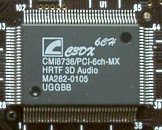 The Zoltrix Nightingale PRO 6 card is based on the CMI8738/PCI-6ch-MX chip. It is the most perfect model in the 8738 chip line from C-Media (except the CMI8738/PCI-6ch model with a modem support). Specification:
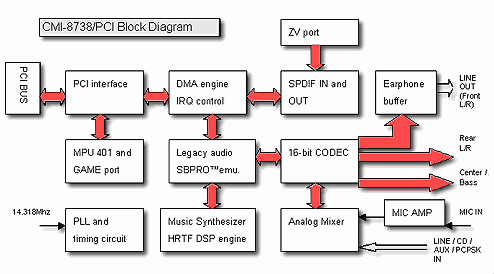 The CMI8738 is mainly an HSP solution (though a small DSP unit for calculation of HRTF is provided) which is primarily based on drivers and which loads the CPU with computation. It means that all 3D sound APIs are realized on a software level, and the stream mixing quality and sounding is defined by the drivers of the card. And now a few words about the digital abilities. It is difficult to use the chip's possibilities of 24-bit sound receive/transmitting since the chip contains the converters fixed for 16 bits and has no digital interfaces for connection of converters of another bit capacity. InstallationInstallation of the drivers and the programs was easy. Test system:
Operating system: Win98SE (4.10.2222A) with DirectX8.0a installed. During the installation you may choose a driver version: 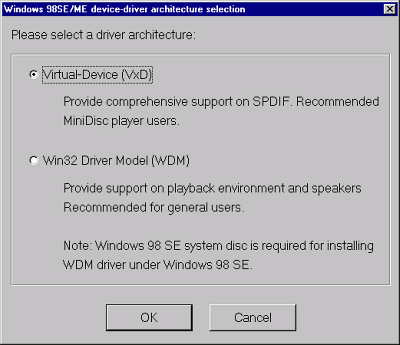 Usually the VxD drivers use the resources of the hardware and of the operating system completely. At the same time, their WDM version has wider compatibility. The drivers were installed on a virgin operating system. After that the following devices appeared:  The following files control functionality of the card:
When the WDM drivers are installed we can see the following picture:  The libraries of the drivers have the following versions:
The WDM version differs from the VxD drivers in settings and functions. The VxD drivers have the following peculiarities:
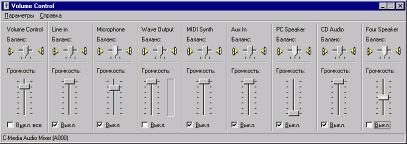 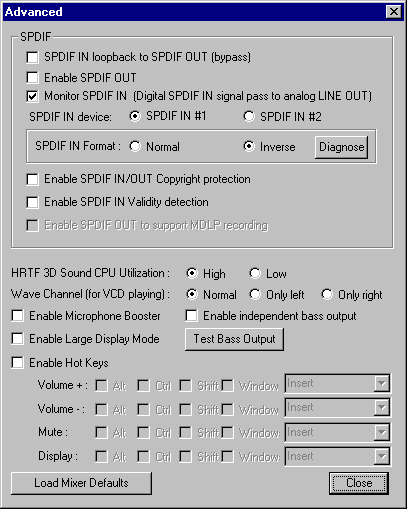 Peculiarities of the WDM drivers:
Let's examine the latter item in detail. The first panel is identical to the upper part of the panel of the extended settings of the VxD drivers. 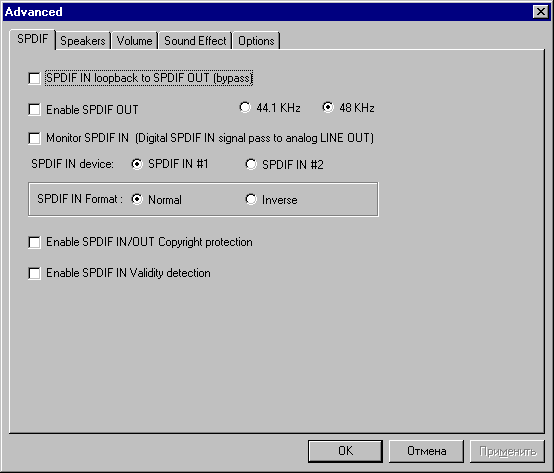 The option "SPDIF IN loopback to SPDIF OUT (bypass)" will be useful if you are going to apply a digital signal of one digital device to another (e.g. from Digital Out of the CD-ROM drive to the external converter). "Enable SPDIF OUT" is exactly what is written. Besides, you can choose a reference sampling frequency. "Monitor SPDIF IN" means a digital signal is monitored through the DAC of the card. "SPDIF IN device" is where you are to choose an input (see the input/output scheme). The Live! cards have also 2 digital S/PDIF-INs: CD-Digital IN and S/PDIF IN. But while on the cards with the EMU10K these inputs work simultaneously and both are present in the mixer, in case of the CMI8738 based cards the number of digital-ins may differ from the number of the ports in the chip. That is why one has to choose an input for taking a signal from. "SPDIF IN Format" is a normal inverted signal format. In the Normal position in my computer with the DVD drive Creative 5X the right channel produced hum while the left one "didn't say a word". It seems to be a bug of the driver or it may be the chip to blame. "Enable SPDIF IN/OUT Copyright protection" enables the 29th bit in each subframe of the data block of the S/PDIF protocol. This function restricts or permits some minidesk decks to write/transfer a signal with the help of digital-in/out's. "Enable SPDIF IN Validity detection" works with the 28th bit of subframe which indicates the correctness of data transfer. This option may be enabled if you are sure in the quality of the CD-Digital cable and of the digital transmitting part of the CD-ROM drive. After I enabled this option nothing could be heard. It means either constant transmission errors or errors in the algorithms. The second panel deals with operating modes of the card - standard presets for the 5.1 sound card. Headphones and 2 speakers sound equally when playing music. The differences can be noticed only in games which use different HRTF presets. 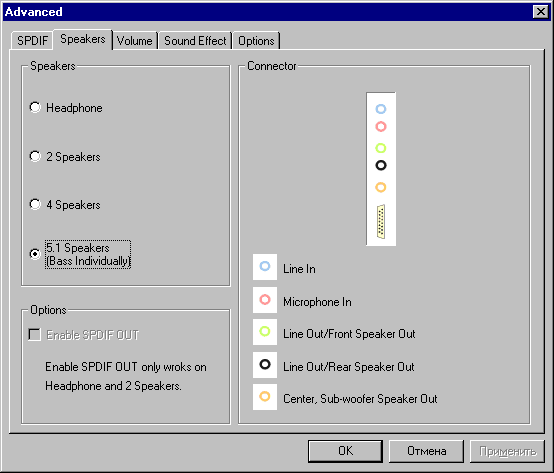 The third panel contains separate regulators for all 6 analog channels. 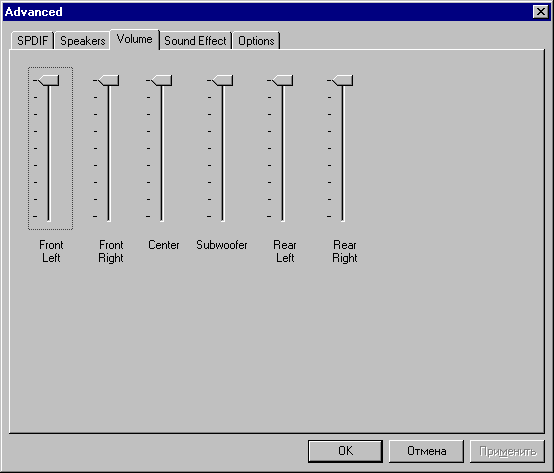 On the next panel you can choose a preset of the reverb. 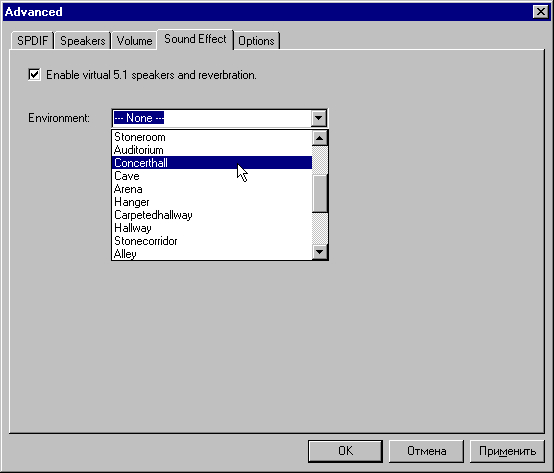 On the last panel you can set hot keys for volume control. There is also an option for preamplification of a signal coming from the mic-in. The "Load Mixer Default" button didn't work. 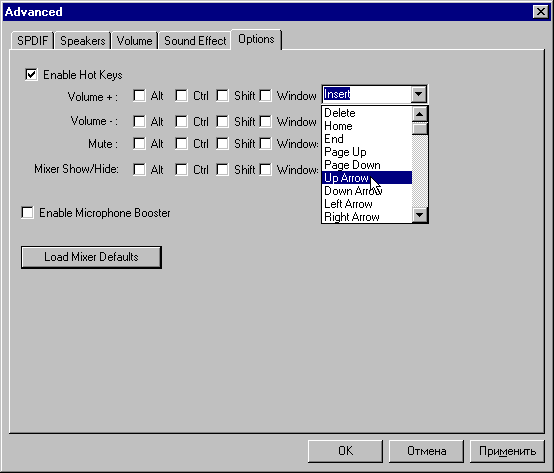 The lack of a possibility to disable analog-ins in the WDM drivers made impossible their usage in tests. For the CMI8738 based cards there are VxD/WDM drivers which combine the best features of both families. Internal digital-inAdvanced users are usually interested in:
Let's start with the digital-in of the Zoltrix Nightingale PRO 6. If you want to get a high-quality signal from a digital-in you should connect to it an output of the CD-ROM drive. For the test we used a CD-DA disc with 2 recorded signals: 15 kHz, -3 dB (FS) and the one processed by dithering in order to eliminate the correlation of quantization noise with a signal. The test was conducted in the SpectraLAB v4.32.14. 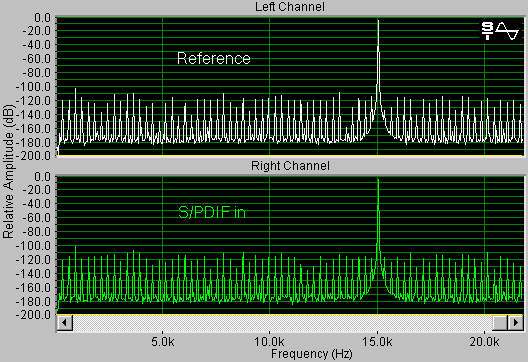 "Usual" sinusoidal signal
 Sinusoidal signal with dithering
The card shows excellent results! Now let's enable the monitoring of the digital-in and apply the signal to the built-in DAC of the CMI8738 chip (the signal was recorded with the EgoSys Waveterminal 2496 professional sound card from its analog input). 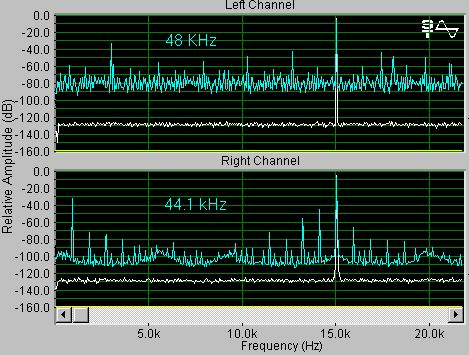 Sinusoidal signal with dithering
The signal is not ideal. When I listened to the music from a CD on a good acoustic system or in headphones, I heard constant noise and noticed distortions at high frequencies. And what about mids? Here are the spectrograms:  Sinusoidal signal with dithering
So, the signal at the mids is much better than at the highs. It means the card is not suitable for listening to high quality CD-DAs thru its own DACs. Tests of DAC and analog outputsIn order to get the more complete information on the quality of the 16-bit digital-to-analog converters of the CMI8738 chip and of the analog buffer elements let's look at the complex tests of our program RightMark Audio Analyzer. Tested chain: Zoltrix Nightingale PRO 6 Front Out - WT2496 Line
In
General performance: Good (in detail) Tested chain: Zoltrix Nightingale PRO 6 Front Out - WT2496 Line
In
General performance: Good (in detail) Although the DACs have not the best characteristics yet at 1 kHz, such sound suits games and 128 Kbit/s MP3 files played on inexpensive computer speakers since their THD is often almost 10%! You may compare the results of the Zoltrix Nightingale PRO 6 with other modern 6-channel cards in the review Philips Seismic Edge and Rhythmic Edge sound cards. Performance in gamesAs we have already said the EAX 2.0 is supported only in WDM drivers. For this test we used the Serious Sam game which can measure the average value of frames per second at the time of playing of the recorded scene. First we taped dem_bProfile=1 <Enter> in the console and started the first demo. The settings are: Normal, 1024X768X32bit. The tests were carried out three times for each case, then we calculated the average. The spread in values didn't exceed +/-0.1 fps. X-axis: fps.  The worst performance drop is 16%, on the Athlon 1.3 GHz based computer. On a less powerful system with a weak video card the difference won't be so clear. But the processor utilization will still depend on the drivers and on the card mode (DS3D, EAX). Digital possibilities of the CMI8738 chipNow a bit on the set of players from C-Media. I must admit that apart from a terrible design this player doesn't suit for reading CDs via the IDE bus ("Using CD-DA to playback the CD" mode).  The sound in exactly this mode and exactly on this player comes out of the speakers jerkily. Such problems sometimes happen on other cards based on the CMI8738 chip. But there is a way out. You should use a CD-IDE plug-in for the Winamp called CD Reader. This plug-in is widely compatible with various CD-ROM drives and has a great deal of useful settings which can be found this way: Options / Preferences / Plug-ins / Input / CD Reader / Drives / Configure. Now about 24-bit possibilities of the CMI8738. The drivers allow playing 24-bit files at almost any sampling frequency, but you can't listen to them. The card, however, can convert the sound into 16bit on the fly and allows monitoring it with the DACs. 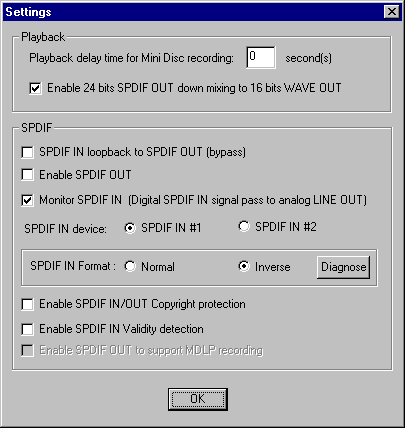 If a file can't be played because of, for example, a sampling frequency exceeding 48 kHz, then it will be marked with a criss-cross in a play list. 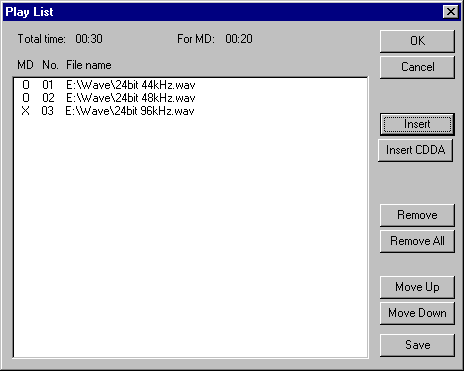 It is hard to say who may need the modes of 24-bit 44.1/48 kHz. But let's look at least at the characteristics of the digital-out at 16-bit 44.1 kHz. Tested chain: Zoltrix SPDIF Out - WT2496 SPDIF In
General performance: Excellent (in detail) For the test we used a usual $4 audio-video cable from Luxmann. But the characteristics are, at the same time, outstanding! This chip doesn't affect a signal which is applied to its digital-out. Now let's look at other cards which can't give directly a digital signal at 44.1 kHz and which use resampling into 48 kHz. Is the situation really so bad? The Live! Value and the SQ2500 Vortex2 (AU8830) will help us to clarify it. The Live! was tested with the "S/PDIF Output only" disabled. Tested chain: Live! Value SPDIF Out - WT2496 SPDIF In
General performance: Very good (in detail) The Vortex2 was tested with VxD drivers of v2.016, 2048, 2050. The v2.016 is not very good. The maximum amplitude of the digital signal didn't exceed -6 dB (FS). In the output mode at 44.1 kHz the digital signal on the Vortex2 cards is twice converted: 44.1->48->44.1 kHz, that is why the distortions grow incredibly (THD+N = 0.1%)! 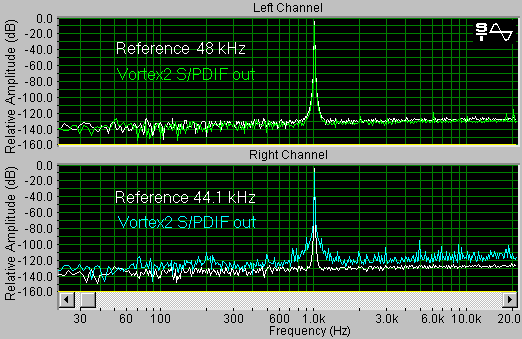 The drivers of the v2048 are much better. Now in the digital mode the 0 dB signal is at the full scale level. But the output mode of a digital signal at 44.1 kHz is overloaded when the signal level exceeds -6 dB FS. Now the drivers of v2050. Despite the Added S/PDIF 44.1kHz support on AU8830 these drivers are not better than the 2048. In all cases the drivers were installed on a virgin system; the disc image was prepared by the Norton Ghost program, and all devices installed had no clashes on a hardware level. Well, I felt disappointed because of impossibility to measure the characteristics of the S/PDIF-out of the SQ2500, but then an idea crossed my mind: what if I just play a 44.1 kHz signal in the digital output mode at 48 kHz? Thus I can avoid problems of double resampling. But in such mode the Waveterminal lost synchronization. So I had to set the measuring card from EgoSys into the mode of generation of its own reference frequency, without taking into account the readings of the coming signal and enabling the Sample Rate Converter in the mode 48kHz-to-48kHz (it is not an erratum). The signal now is easy to discern. The results are below. Tested chain: SQ2500 SPDIF Out - WT2496 SPDIF in
General performance: Very good (in detail) Now, if you compare these characteristics with the parameters of the digital-out of the Zoltrix Nightingale PRO 6 you will see that it makes no sense to replace a sound card with a fixed 48 kHz sampling frequency of the digital signal on the S/PDIF-out with a card based on the CMI8738 chip. ConclusionThis Zoltrix Nightingale PRO 6 card of the 1.1 revision is, possibly, the best solution on the 6-channel version of the CMI8738 chip all around the world. Highs:
Lows:
Write a comment below. No registration needed!
|
Platform · Video · Multimedia · Mobile · Other || About us & Privacy policy · Twitter · Facebook Copyright © Byrds Research & Publishing, Ltd., 1997–2011. All rights reserved. |